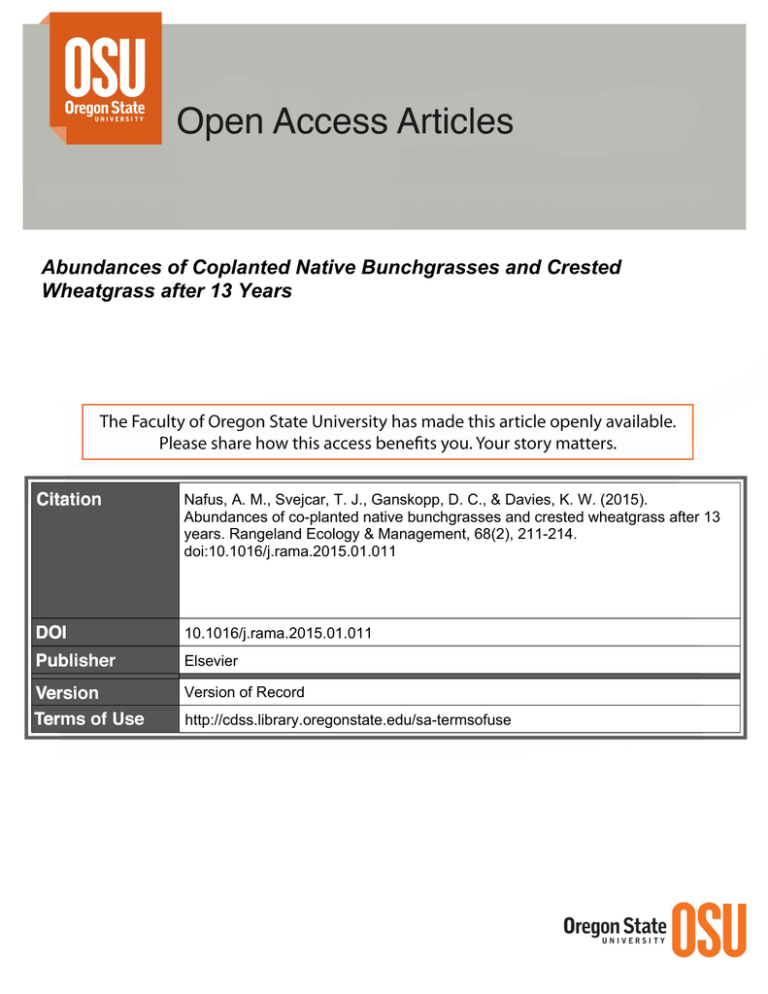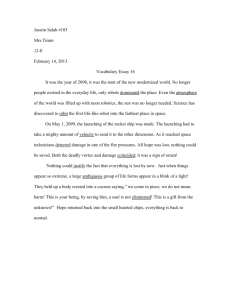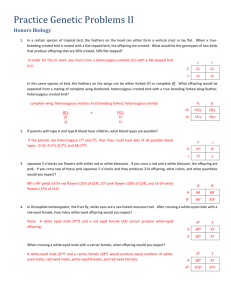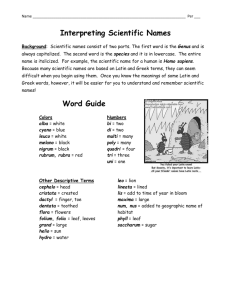
Abundances of Coplanted Native Bunchgrasses and Crested
Wheatgrass after 13 Years
Nafus, A. M., Svejcar, T. J., Ganskopp, D. C., & Davies, K. W. (2015).
Abundances of co-planted native bunchgrasses and crested wheatgrass after 13
years. Rangeland Ecology & Management, 68(2), 211-214.
doi:10.1016/j.rama.2015.01.011
10.1016/j.rama.2015.01.011
Elsevier
Version of Record
http://cdss.library.oregonstate.edu/sa-termsofuse
Rangeland Ecology & Management 68 (2015) 211–214
Contents lists available at ScienceDirect
Rangeland Ecology & Management
journal homepage: http://www.elsevier.com/locate/rama
Abundances of Coplanted Native Bunchgrasses and Crested
Wheatgrass after 13 Years☆,☆☆
Aleta M. Nafus a,⁎, Tony J. Svejcar b, David C. Ganskopp c, Kirk W. Davies d
a
Graduate Student, Oregon State University, Corvallis, OR 97330, USA
Research Leader, U.S. Department of Agriculture, Agricultural Research Service, Burns, OR 97720, USA
Emeritus Rangeland Scientist, U.S. Department of Agriculture, Agricultural Research Service, Burns, OR 97720, USA
d
Rangeland Scientist, U.S. Department of Agriculture, Agricultural Research Service, Burns, OR 97720, USA
b
c
a r t i c l e
Keywords:
Agropyron cristatum
restoration
revegetation
sagebrush steppe
i n f o
a b s t r a c t
Crested wheatgrass (Agropyron cristatum [L] Gaertm) has been seeded on more than 5 million hectares in
western North America because it establishes more readily than native bunchgrasses. Currently, there is
substantial interest in reestablishing native species in sagebrush steppe, but efforts to reintroduce native
grasses into crested wheatgrass stands have been largely unsuccessful, and little is known about the
long-term dynamics of crested wheatgrass/native species mixes. We examined the abundance of crested
wheatgrass and seven native sagebrush steppe bunchgrasses planted concurrently at equal low densities
in nongrazed and unburned plots. Thirteen years post establishment, crested wheatgrass was the dominant
bunchgrass, with a 10-fold increase in density. Idaho fescue (Festuca idahoensis Elmer), Thurber’s
needlegrass (Achnatherum thurberianum (Piper) Barkworth), basin wildrye (Leymus cinereus [Scribn. &
Merr.] A. Löve), and Sandberg bluegrass (Poa secunda J. Presl) maintained their low planting density,
whereas bluebunch wheatgrass (Pseudoroegneria spicata [Pursh] A. Löve), needle-and-thread
(Hesperostipa comata [Trin. & Rupr.] Barkworth), and squirreltail (Elymus elymoides [Raf.] Swezey) densities
declined. Our results suggest that densities of native bunchgrasses planted with crested wheatgrass are unlikely to increase and that some species may only persist at low levels. The high recruitment of crested
wheatgrass suggests that coplanting of some native bunchgrasses may be a viable way of avoiding crested
wheatgrass monocultures when this species is necessary for rehabilitation or restoration.
© 2015 Society for Range Management. Published by Elsevier Inc. All rights reserved.
Introduction
Crested wheatgrasses (Agropyron cristatum [L] Gaertm. and
Agropyron desertorum [Fisch.] Schult.) have been seeded on more
than 5 million hectares across semiarid and arid western North
American rangelands (Maryland et al., 1992). In the Intermountain
West, crested wheatgrass is often seeded in mixes with native species
(Pellant and Lysne, 2005). It is relatively cost effective, establishes
readily, and, as it is highly competitive with undesirable weedy species (Arredondo et al., 1998; Eiswerth et al., 2009), may facilitate establishment of more desirable native vegetation (Cox and Anderson,
☆ Research was funded in part by the Bureau of Land Management Great Basin Native Plant Selection and Increase Project with additional support provided by the
USDA–Agricultural Research Service and the Oregon Dept of Fish and Wildlife.
☆☆ Mention of a proprietary product does not constitute a guarantee or warranty of
the product by USDA or the authors and does not imply its approval to the exclusion
of the other products that also may be suitable. USDA is an equal opportunity provider
and employer.
⁎ Correspondence: USDA–Agricultural Research Service, 67826-A Hwy 205,
Burns, OR 97720, USA.
E-mail address: aleta.nafus@oregonstate.edu (A.M. Nafus).
2004). However, the competitive nature of crested wheatgrass can
result in monoculture stand formation and seed bank domination
(Pyke, 1990), which can both hinder establishment of native species
(Gunnell et al., 2010; Marlette and Anderson, 1986) and induce native species displacement and low biological diversity (Christian
and Wilson, 1999; Krzic et al., 2000; Vaness and Wilson, 2008).
When crested wheatgrass is included in seed mixtures with native
species, crested wheatgrass frequently becomes dominant
(Heinrichs and Bolton, 1950; Knutson et al., 2014; Schuman et al.,
1982); however, it remains relatively unclear as to whether crested
wheatgrass excludes natives or if natives just fail to establish. Efforts
to remove crested wheatgrass and reseed natives rarely increases native vegetation establishment (Fansler and Mangold, 2011; Hulet
et al., 2010). Native herbaceous vegetation has successfully
reestablished in some crested wheatgrass communities (Williams,
2009); however, because most studies are shorter than 5 years, little
is known about the ability of established native bunchgrasses to coexist with crested wheatgrass more than a decade after planting.
Successfully established native vegetation produces seed, potentially increasing the availability of seed on a site. Edwards and
Crawley (1999) suggest that seed rain is likely critical for maintaining
http://dx.doi.org/10.1016/j.rama.2015.01.011
1550-7424/© 2015 Society for Range Management. Published by Elsevier Inc. All rights reserved.
212
A.M. Nafus et al. / Rangeland Ecology & Management 68 (2015) 211–214
a species. If established native vegetation species coexist with crested
wheatgrass, they may provide a seed source that allows for continued
recruitment, persistence, and even increases of native vegetation in
crested wheatgrass communities. Alternatively, because crested
wheatgrass frequently dominates the seedbank and is more competitive than many native species at the seedling stage, it may thereby exclude or a least limit the recruitment of native vegetation (Gunnell
et al., 2010). Therefore more information is needed about the potential likelihood of native bunchgrass species to maintain their presence
the community after co-establishment with crested wheatgrass.
To evaluate the long-term response of native perennial bunchgrasses when coplanted with crested wheatgrass, we looked at
bunchgrass species abundance 13 years after simultaneous planting.
We hypothesized that the density of each native bunchgrass species
would decrease over time and that crested wheatgrass would become the dominant bunchgrass.
Methods
Study Area
The study site is located on the Northern Great Basin Experimental Range (lat 43 28′48.3′′N, long − 119 42′32.2′′W, elev 1/403
m) 56 km west of Burns, Oregon. Average annual precipitation at
the site is 286 mm, typically arriving as snow or rain from October
to March (data file, Eastern Oregon Agricultural Research Center,
Burns, OR). Soils at the site are a complex of loam and loamy fine
sands (Milican coarse-loamy, mixed, frigid Orthidic Durixerolls and
Holte coarse-loamy, mixed, frigid Orthidic Haploxerolls, respectively
(Lentz and Simonson, 1986; Ganskopp et al., 2007). Depth to bedrock
or hardpan ranged from 90–150 cm (Ganskopp et al., 2007).
Vegetation in neighboring pastures is characterized by Wyoming
big sagebrush (Artemisia tridentata subsp. wyomingensis Beetle) overstory with a diverse understory that contained all of the native
bunchgrasses evaluated in this study.
Experimental Design
In 1989 nine 313-m 2 plots were established in a site cleared of
vegetation for a paddock study using methods outlined in Cruz and
Ganskopp (1998) and Ganskopp et al. (2007). Seven native bunchgrass species, bluebunch wheatgrass (Pseudoroegneria spicata
[Pursh] A. Löve), basin wildrye (Leymus cinereus [Scribn. & Merr.] A.
Löve), Idaho fescue (Festuca idahoensis Elmer), bottlebrush
squirreltail (Elymus elymoides [Raf.] Swezey), needle-and-thread
(Hesperostipa comata [Trin. & Rupr.] Barkworth), Sandberg bluegrass
(Poa secunda J. Presl), and Thurber’s needlegrass (Achnatherum
thurberianum [Piper] Barkworth) and one introduced bunchgrass
species, “Nordan” crested wheatgrass, were transplanted into each
plot as mature plants harvested from nearby plant communities.
The bunchgrass species were planted so that each plot contained
2.6 total plants or 0.33 plants per species · m −2 randomly assigned
to an evenly spaced grid of 29 rows and 29 columns (resulting in
841 cells) with plants positioned at the center of each cell such that
there were 0.61 m between plant centers. This resulted in a total of
800 (100 per species) planted cells and 41 randomly distributed
empty cells in each plot. In 1998 the site was weeded and restocked
with transplants from nearby communities when necessary to
achieve original plant densities (Ganskopp et al., 2007). Except for
the 1998 experiment (Ganskopp et al., 2007), domestic livestock
grazing was excluded since 1989. Since the last treatment in
1998, the communities were left to the natural processes of recruitment and mortality.
Vegetation Measurement and Statistical Analyses
In 2011, we recreated the original grid described earlier and
counted, by species, the bunchgrasses in each plot. To determine
whether there was a change in species abundance over time, we
used repeated measures multivariate analysis of variance (MANOVA)
with density in 1998 and density in 2011 as response variables and
species as an independent variable in JMP 10.0.2. To determine
which species were different, we used a pairwise comparison with
the Tukey HSD adjustment obtained using an analysis of variance
(ANOVA) on the change in abundance grouped by species in R
(version 3.0.2). This change in abundance was the 1998 abundance
subtracted from the 2011 abundance. In order to determine the effect
of time on individual species, we used a one sample two-tailed t-test
to compare the 2011 abundance of each species to the null starting
(1998) abundance using R (version 3.0.2; R Core Team, 2013). Results
were reported as density · m−2. Abundance data were normally distributed, and a transformation was not used. Means were reported
with standard error of means (SE). For the t-tests, significance was
set at a conservative P b 0.006 (0.05/8) to reduce the chance of type
I error. All P values refer to t-test results unless otherwise indicated.
Results
The MANOVA revealed a significant effect for the interaction of species and time (F [7, 64] = 29.5, P b .001). Given the significance of the
overall test, an ANOVA was used to examine the change in species
abundance, which showed there was an increase in total bunchgrass
density from 2.64 plants · m−2 (8 species at 0.33 plants · m−2 each)
in 1998 to 5.23 ± 0.02 plants · m −2 in 2011 (P b 0.001, F [7, 64] =
260.0). The Tukey pairwise comparison revealed that crested
wheatgrass had the greatest increase in density in the community:
a 10-fold increase in density over the 13-year period (3.37 ± 0.35
plants · m −2; P b 0.001; Fig. 1). Crested wheatgrass comprised 64% of
the total bunchgrass abundance. The native bunchgrasses each contributed between 3% and 8% of the remaining bunchgrass abundance.
Idaho fescue was the only native grass that slightly increased in
density, by about 0.1 plants . m2 to 0.43 ± 0.13 plants · m−2. However, its response was highly variable (Fig. 1) and was not strongly statistically significant (P = 0.07). Thurber’s needlegrass, Basin
wildrye, and Sandberg bluegrass maintained a similar density
over time (0.28 ± 0.08, 0.26 ± 0.04, and 0.32 ± 0.20, respectively; P
N 0.01; Fig. 1). In contrast, squirreltail, needle-and-thread, and
bluebunch wheatgrass decreased over the 13-year study interval
(0.17 ± 0.07, 0.20 ± 0.03, and 0.19 ± 0.06 plants · m −2, respectively;
P ≤ 0.001; Fig. 1), with squirreltail experiencing the greatest decline
(ca. 50%).
Discussion
As we hypothesized, crested wheatgrass became dominant in the
community after 13 years. Similar to other, more short-term studies
(see Grant-Hoffman et al., 2012; Heidinga and Wilson, 2002), we
found that crested wheatgrass rapidly became the most abundant
bunchgrass in the mixed-grass community, and increases in crested
wheatgrass were often, though not always, associated with declines
in native grasses. The presence of established native species may reduce the extent of crested wheatgrass dominance (Bakker and
Wilson, 2004), potentially slowing the recruitment of crested wheatgrass into the community. The relatively stable density of Idaho fescue, Thurber’s needlegrass, Basin wildrye, and Sandberg bluegrass
over our 13-year study suggests that these species may persist in
sagebrush steppe when coplanted with crested wheatgrass, especially at our elevation and sparse planting densities. Other studies have
A.M. Nafus et al. / Rangeland Ecology & Management 68 (2015) 211–214
213
Fig. 1. Average density of perennial bunchgrasses in 2011. Starting density was 0.33 plants m−2 in 1998 (dashed line). Asterix indicates a statistically significant (P b 0.05) difference
in density between 1998 and 2011. Note scale change on y axis. below solid reference line.
found that Sandberg bluegrass is less negatively impacted by the
presence of crested wheatgrass than other species (e.g., bluebunch
and needle-and-thread grass) and can coexist with crested wheatgrass (Broersma et al., 2000; Heidinga and Wilson, 2002; Henderson and Naeth, 2005), possibly because it grows and senesces
earlier than other bunchgrasses (James et al., 2008), which may
allow it to avoid competition for scarce moisture resources.
It is difficult to determine whether those species that showed declines in density (squirreltail, needle-and-thread, bluebunch wheatgrass) will simply have a decreased presence in the community or
whether declines will lead to their eventual extirpation. Similar to
our results, Henderson and Naeth (2005) found that bluebunch
wheatgrass decreased when it coexisted in communities with crested
wheatgrass. Squirreltail also tends to be negatively correlated with
crested wheatgrass abundance (Davies, 2010; Grant-Hoffman et al.,
2012) despite its greater ability to effectively compete with crested
wheatgrass at the seedling stage than other native bunchgrasses
(Gunnell et al., 2010).
We found that crested wheatgrass appears to be filling available
open spaces while the density of native bunchgrasses remained static
or decreased slightly. Perennial bunchgrasses in our study sites were
spaced at even distances from one another and at relatively low densities. This is a stark contrast to the clumping of bunchgrasses in drill
rows with drill seeding, which may alter plant community dynamics.
The ability of crested wheatgrass to recruit high numbers of individuals relative to native bunchgrasses in coplanted communities means
that even if native bunchgrasses are established into existing stands
of crested wheatgrass, their presence is unlikely to increase in the
community. The dominance of crested wheatgrass suggests that efforts to diversify crested wheatgrass stands with native bunchgrasses
may not be successful without significant and lasting control of crested wheatgrass. Knutson et al. (2014) found evidence suggesting that
planting native bunchgrasses is most successful when crested wheatgrass is not included in the seed mixture. When native species do successfully establish with crested wheatgrass, they often decrease
within 3 years (Davies, 2010; Fansler and Mangold, 2011; Hulet
et al., 2010). However, despite decreases in some species, migration
of the coplanted native bunchgrasses into neighboring cells suggests
that they were recruiting into the plant community; even if at low
levels, and so may maintain a presence in the community. Presence
of larger native species may be underestimated in our study because
cover or plant size was not measured and species like Basin wildrye
have a stronger presence than density can indicate. The high recruitment of crested wheatgrass helps explain why its presence can limit
exotic annual grasses, especially in wetter, cooler environments such
as our study site (Knutson et al., 2014), and why, in some situations,
crested wheatgrass may be selected for seeding when the goal is to
reduce the risk of exotic annual grass invasion and dominance,
particularly following a wildfire event (Davies, 2010).
Although our experiment is replicated at one site only, it is a valuable contribution to our understanding of the relationship between
crested wheatgrass and native perennial bunchgrasses as there are
few studies with a similar combination of duration and experimental
control. Our study provides a unique opportunity to examine longterm changes in abundance of native bunchgrasses established
alongside crested wheatgrass in the sagebrush steppe. Longer-term
monitoring will be necessary to determine whether the community
maintains its diversity or eventually converts to a near monoculture
stand of crested wheatgrass. Further evaluations at sites with varying
site and climatic characteristics may help identify the species that are
more likely to effectively coexist with crested wheatgrass across its
seeded range.
Management Implications
The 10-fold increase in crested wheatgrass density and decrease
in half of the native bunchgrass species raise the question of how effective simultaneous seedings of crested wheatgrass and native
bunchgrasses will be if the management objective is for native vegetation to establish and increase. Some native bunchgrass species, in
our case, Sandberg bluegrass, Thurber’s needlegrass, and Idaho fescue, may be more likely to maintain a presence in the community,
though the most suitable species will likely also differ depending on
site characteristics. We had an evenly dispersed, low-density planting, which may reduce competitive interactions compared with a
more typical seeding where plants tend to emerge at higher densities.
If crested wheatgrass is necessary to reclaim a site or reduce exotic
annual grass invasion, it may be an ineffective use of resources to
214
A.M. Nafus et al. / Rangeland Ecology & Management 68 (2015) 211–214
seed those native bunchgrass species that are less likely persist over
long time periods. Our results suggest that if native bunchgrasses
are likely to establish and meet management objectives, it may be undesirable to include crested wheatgrass because it will likely increase
at greater rates than native bunchgrasses.
Acknowledgments
The authors thank J. Garner, S. Fitzpatrick, S. Duff, R. Johnson,
and B. Carlon for their assistance with data collection. We are
grateful to April Hulet and Erik Hamerlynck for reviewing earlier
revisions of this manuscript. We also appreciate the thoughtful reviews of anonymous reviewers.
References
Arredondo, J.T., Jones, T.A., Johnson, D.A., 1998. Seedling growth of Intermountain perennial and weedy annual grasses. Journal of Range Management 51, 584–589.
Bakker, J.D., Wilson, S.D., 2004. Using ecological restoration to constrain biological invasion. Journal of Applied Ecology 41, 1058–1064.
Broersma, K., Krzic, M., Thompson, D.J., Bomke, A.A., 2000. Soil and vegetation of ungrazed
crested wheatgrass and native rangelands. Canadian Journal of Soil Science 80, 411–417.
Christian, J.M., Wilson, S.D., 1999. Long-term ecosystem impacts of an introduced grass
in the northern Great Plains. Ecology 80, 2397–2407.
Cox, R.D., Anderson, V.J., 2004. Increasing native diversity of cheatgrass-dominated
rangeland through assisted succession. Journal of Range Management 57, 203–210.
Cruz, R., Ganskopp, D., 1998. Selective differences between native and experienced cattle foraging among eight grasses. Applied Animal Behaviour Science 62, 293–303.
Davies, K.W., 2010. Revegetation of medusahead-invaded sagebrush steppe. Rangeland Ecology & Management 63, 564–571.
Edwards, G.R., Crawley, M.J., 1999. Herbivores, seed banks, and seedling recruitment in
mesic grasslands. Journal of Ecology 87, 423–435.
Eiswerth, M.E., Krauter, K., Swanson, S.R., Zielinski, M., 2009. Post-fire seeding on Wyoming big sagebrush ecological sites: regression analyses of seeded nonnative and
native species densities. Journal of Environmental Management 90, 1320–1325.
Fansler, V.A., Mangold, J.M., 2011. Restoring native plants to crested wheatgrass
stands. Restoration Ecology 19, 16–23.
Ganskopp, D., Aguilera, L., Vavra, M., 2007. Livestock forage conditioning among six
northern great basin grasses. Rangeland Ecology and Management 60, 71–78.
Grant-Hoffman, M.N., Clements, A., Lincoln, A., Dollerschell, J., 2012. Crested wheatgrass
(Agropyron cristatum) seedings in Western Colorado: what can we learn? Management of Biological Invasions 3, 89–96.
Gunnell, K.T., Monaco, T.A., Call, C.A., Ransom, C.V., 2010. Seedling interference and
niche differentiation between crested wheatgrass and contrasting native great
basin species. Rangeland Ecology & Management 63, 443–449.
Heidinga, L., Wilson, S.D., 2002. The impact of an invading alien grass (Agropyron
cristatum) on species turnover in native prairie. Diversity and Distributions 8,
249–258.
Heinrichs, D.H., Bolton, J.L., 1950. Studies on the competition of crested wheat-grass
with perennial native species. Scientific Agriculture 30, 428–443.
Henderson, D.C., Naeth, M.A., 2005. Multi-scale impacts of crested wheatgrass invasion
in mixed-grass prairie. Biological Invasions 7, 639–650.
Hulet, A., Roundy, B.A., Jessop, B., 2010. Crested wheatgrass control and native plant
establishment in Utah. Rangeland Ecology & Management 63, 450–460.
James, J.J., Davies, K.W., Sheley, R.L., Aanderud, Z.T., 2008. Linking nitrogen partitioning
and species abundance to invasion resistance in the Great Basin. Oecologia 156,
637–648.
JMP, 1989–2007. Version 10.0.2. computer program. SAS Institute Inc, Cary, NC, USA.
Knutson, K.C., Pyke, D.A., Wirth, T.A., Arkle, R.S., Pilliod, D.S., Brooks, M.L., Chambers,
J.C., Grace, J.B., 2014. Long-term effects of seeding after wildfire on vegetation in
Great Basin shrubland ecosystems. Journal of Applied Ecology 51, 1414–1424.
Krzic, M., Broersma, K., Thompson, D.J., Bomke, A.A., 2000. Soil properties and species
diversity of grazed crested wheatgrass and native rangelands. Journal of Range
Management 53, 353–358.
Lentz, R.D., Simonson, G.H., 1986. A detailed soil inventory and associated vegetation
of Squaw Butte Range Experimental Station. Oregon Agricultural Experiment Station Special Report 760, Corvallis, OR, USA (184 pp.).
Marlette, G.M., Anderson, J.E., 1986. Seed banks and propagule dispersal in crestedwheatgrass stands. Journal of Applied Ecology 23, 161–175.
Maryland, H.F., Asay, K.H., Clark, D.H., 1992. Seasonal trends in herbage yield and quality of Agropyrons. Journal of Range Management 45, 369–374.
Pellant, M., Lysne, C.R., 2005. Strategies to enhance plant structure and diversity in
crested wheatgrass seedings. In: Shaw, N.L., Pellant, M., Monsen, S.B. (Eds.),
Sage-grouse habitat restoration symposium proceedings; RMRS-P-38. USDA, Forest Service, Rocky Mountain Research Station, Fort Collins, CO, USA, pp. 81–92.
Pyke, D., 1990. Comparative demography of co-occurring introduced and native tussock grasses: persistence and potential expansion. Oecologia 82, 537–543.
R Core Team, 2013. R: A language and environment for statistical computing. R Foundation for Statistical Computing, Vienna, Austria (Available at: URL http://www.Rproject.org/).
Schuman, G.E., Rauzi, F., Booth, D.T., 1982. Production and competition of crested
wheatgrass-native grass mixtures. Agronomy Journal 74, 23–26.
Vaness, B.M., Wilson, S.D., 2008. Impacts and management of crested wheatgrass
(Agropyron cristatum) in the northern Great Plains. Canadian Journal of Plant Science 87, 1023–1028.
Williams, J.R., 2009. Vegetation characteristics of Wyoming big sagebrush communities historically seeded with crested wheatgrass. thesis, Utah State University,
Logan UT, USA (89 pp.).







